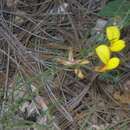Physical Description
provided by USDA PLANTS text
Perennial, Herbs, Taproot present, Nodules present, Stems erect or ascending, Stems less than 1 m tall, Stems solid, Stems or young twigs sparsely to densely hairy, Leaves alternate, Stipules inconspicuous, absent, or caducous, Stipules persistent, Stipules free, Stipules reduced to glands, Leaves compound, Leaves palmately 2-3 foliate, Leaves palmately 5-11 foliate, Leaf or leaflet margins entire, Leaflets opposite, Leaflets 3, Leaflets 4, Leaflets 5-9, Leaves glabrous or nearly so, Flowers solitary in axils, or appearing solitary, Inflorescence sessile or subsessile, Inflorescence axillary, Bracts conspicuously present, Flowers zygomorphic, Calyx 5-lobed, Calyx hairy, Petals se parate, Corolla papilionaceous, Petals clawed, Petals red, Petals orange or yellow, Banner petal narrow or oblanceolate, Banner petal ovoid or obovate, Wing petals narrow, oblanceolate to oblong, Wing tips obtuse or rounded, Keel tips obtuse or rounded, not beaked, Stamens 9-10, Stamens or anthers dimorphic, alternating large and small, Stamens diadelphous, 9 united, 1 free, Filaments glabrous, Style terete, Style persistent in fruit, Fruit a legume, Fruit unilocular, Fruit freely dehiscent, Fruit elongate, straight, Fruit or valves persistent on stem, Fruit coriaceous or becoming woody, Fruit exserted from calyx, Fruit internally septate between the seeds, Valves twisting or coiling after dehiscence, Fruit glabrous or glabrate, Fruit hairy, Fruit 2-seeded, Fruit 3-10 seeded, Seeds reniform, Seed surface smooth, Seeds olive, brown, or black.
Ottleya wrightii: Brief Summary
provided by wikipedia EN
Ottleya wrightii, synonym Lotus wrightii, is a species of legume native to the southwestern United States (Arizona, Colorado, New Mexico and Utah). It is also said to occur in Nevada. It is known as Wright's deervetch.
It has yellow flowers on many stems, arising from a single root crown. It was named after Charles Wright.
The Zuni people apply a poultice of the chewed root to swellings that they believe are caused by being witched by a bullsnake.
- license
- cc-by-sa-3.0
- copyright
- Wikipedia authors and editors

